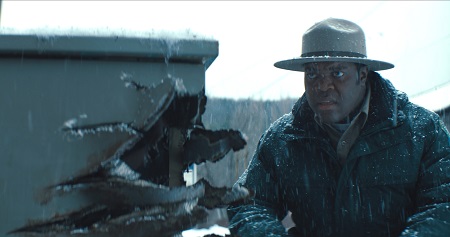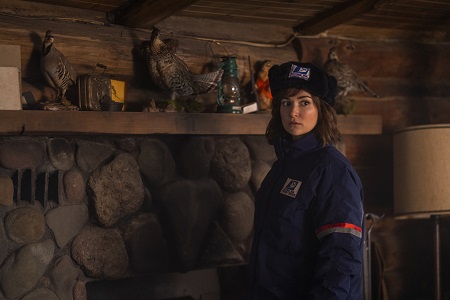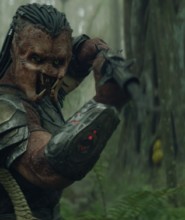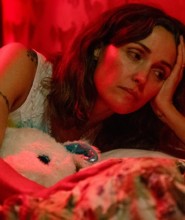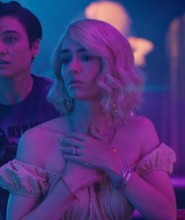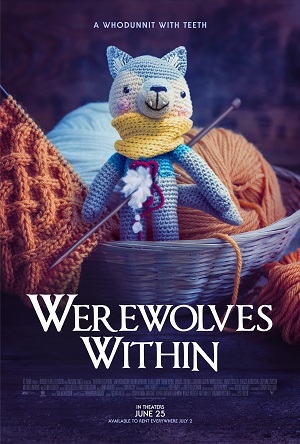
“Werewolves Within” – Interview with Josh Ruben
by Sara Michelle Fetters - June 25th, 2021 - Interviews
A Healing Ride
Josh Ruben balances scares and laughs in Werewolves Within
The rollicking, freewheeling ensemble horror-comedy Werewolves Within is certain to go down as one of 2021’s most entertaining surprises. Based on the popular Ubisoft video game, directed by Josh Ruben and written by Mishna Wolff, the film is an inspired riff on Agatha Christie mystery tropes, wrapped in a tasty shell made up of the blended remnants of classic favorites like Clue, Tremors, Arachnophobia and Knives Out. It’s flat-out terrific, and honestly that’s all that needs to be said.
The basic premise involves a group of disparate characters forced to band together after a snowstorm isolates their tiny community from the rest of the world. Huddled together at the local inn, they quickly realize one of the members of their impromptu party isn’t what they initially appear to be. They are, in fact, a lycanthrope, and like a cat toying with its food, this supernatural creature is just as excited about seeing them tear one another apart out of fear and jealously as they are in making most of them late-night snacks to enjoy sitting in the moonlight.
I touched base with the talented Ruben over Zoom to talk about his follow-up to last year’s wondrous Scare Me. Here are some edited excerpts from our lively conversation:
Sara Michelle Fetters: You debut, Scare Me, is about people trapped in an isolated place by snow. Now you go off and direct somebody else’s script about a group of people trapped in an isolated space by snow. What’s going on? What is it with you and snow?
Josh Ruben: I don’t know. I guess I just have a terrible sense of timing. I don’t know why I can’t shoot in the Hudson Valley in the fall or in the spring. I just have to do it when everybody needs to stuff little heat packets into their gloves and boots. [laughs]
It is purely coincidence. I’ve made two sort-of blizzard quarantine movies. One came out near the beginning of this whole 16 months of madness and one at the end. So that’s kind of crazy.
But, yeah, I do think it can be chalked up to the fact they’re shadow mystery films that take place in the Hudson Valley in the woods. And then you add snow. Snow is sort of dreadful in many ways; it’s a terrifying element. Deadly but so beautiful.
SMF: I am not someone that has been all that hard on a lot of video game films. I’ve enjoyed many of them. But there is a danger when you go off and adapt one; there’s a stigma that’s attached in some circles.
Especially after the success of Scare Me, you still go off and make a movie based on a video game. Was there trepidation on your part in tackling this? Or were you so impressed with Mishna Wolff’s script you were like, “I’m not even going to try to deal with those connotations. We’re going full speed ahead”?
JR: Yes to both. Yes and yes. I mean when [reps from] Vanishing Angle [production company] came to a test screening of Scare Me, they were the ones to ask if I’d be willing to throw my hat in the ring and direct this video game adaptation. My shoulders kind of went up. There were alarm bells.
Then, of course, I opened Mishna’s script and it feels like something between Arachnophobia and Fargo. I couldn’t believe it. I just saw all this comedic potential. It was so visual, so funny.
The next challenge became roping in folks like actors Michael Churnus and Sam Richardson. They were also questioning the source material. Like, wait, this is a video game movie, and it’s called Werewolves Within? And you’re kind of a newcomer? Why would I make this movie?
As soon as I described my intentions, that I wanted to make Fargo as if it were an Amblin film, their shoulders dropped and everyone got excited.
SMF: I love that you bring up Arachnophobia, because immediately after watching I mentioned to someone that the film was like some sort of insane combination of The Beast Must Die, Arachnophobia, Knives Out and Clue, all thrown in a blender and made specifically for me.
JR: I love that! There was a test screening we had where someone mentioned Tremors, and I absolutely lost my mind. I was like, wow, that makes me so happy.
SMF: In the case of, say, Arachnophobia and Tremors, they do a fantastic job of balancing the humor, the character development, and the horror aspects. That can’t be easy. What was your thought process while you’re working through all of this, especially with this talented of a cast? How did you balance these elements and make them feel organic and real?
JR: The main thing is not getting caught trying to be funny. You want actors who are comedically adept. You want to make sure that the ones who are comedians, the ones that come up through the improv world, that they don’t play the scares funny. And that the actors who come from the theater world or from the independent film world, that they don’t play dramatic scenes funny. Everything is a balance. You want everyone to play everything for real within the confines of the boundary these sort of quirky characters come from. You want them to be able to kind of do whatever they want. That’s the biggest thing.
Everything else becomes about style. In the edit, you add this kind of sweeping sort of John Williams score, courtesy of our wonderful composer Anna Drubich. You get kind of a pay-stub editing style that heavily informed our editor Brett Bachman.
Honestly? My biggest concern, aside from finding that balance, was wanting it to make sure that it was smart and that audiences could appreciate what we’re doing. I wanted younger audiences to appreciate it the way that maybe we appreciated Monster Squad when we were kids. But I also wanted it to be done in a way adults could appreciate the way that they did something like Knives Out.
SMF: I’m glad you bring that up, because I think why I love this movie so much is, yes, it’s funny, and yes, the performances are endearing and great across the board, but the mystery works. That to me is the key of the whole thing. The mystery has to work.
How much time did you and Mishna spend on making sure you had a solid mystery?
JR: You’d have to ask Mishna about how much she worked on that during the writing process, because it was really fun to read that very first draft before I got in there myself and started on the director’s rewrite.
It was tough at every turn, though, especially when we’re doing our page-by-page with the producers. Once Ubisoft, Vanishing Angle and I sat down and started going through the script, there was a lot of conversation about maintaining the mystery. Should we reveal that? Should this person be in the background of X scene? When you go back and rewatch it, could we implicate X character or Y character?
You can rewatch the film and see some of the conscious choices we made. You can see where not everyone is present in each scene, so you can spot where you might buy that certain characters could have been doing some of the nefarious activities.
It was certainly difficult and scary, but I did as much prep as I possibly could. But there is this wonderful thing about doing something like this with a team. It doesn’t drive me crazy to have multiple notes or to take feedback, because it’s that’s grace and beauty of having great collaborators. Everyone’s there to make sure that the film is going to be the smartest it possibly can be. I certainly couldn’t have done this on my own.
SMF: You have this mystery. You have this comedy. But then you decide to make it even more difficult on yourself and start layering in concepts relating to gender, to identity, to masculinity, to femininity, to sexuality, to gentrification, to the environment, to economic equality. To me, it feels like those pieces are some of the ones you are the most interested in, because you get to make a lot of points in a subtle way, none of which feel didactic. You’re not hammering the viewer over the head with any of them.
JR: I hope not. That’s always kind of the big thing, right? I do think ultimately you’re playing on a somewhat satirical level, but we’ve also got a responsibility as filmmakers, right?
Certainly, for me, being a 37-year-old Caucasian man, these are the kind of films that I want to do. Where there is something you’re saying, and you’re not making something just for the sake of making it. Worst-case scenario, you are casting as diversely as possible, so even if you’re a bit too vague on the themes or with the dialogue, there can always be a subtext at the very least with your casting decisions.
One example? Originally Dr. Ellis was written for a Richard Jenkins type. I had also just seen and fallen in love with Rebecca Henderson. I said, there’s no reason why Dr. Ellis needs to be an older white man. Why don’t we make it this gay woman to play this character? I haven’t seen this. A kind of Sigourney Weaver type. And she’s an absolute hit. People love Rebecca in this movie.
But everybody gets their moment. The entire cast.
Anyway, it’s just something I want to continue to do and do better as I continue to make stuff. Ideally I do stuff that doesn’t center on anything like identity and that just becomes part of the mixture organically. It adds texture.
It’s like the casting of Sam Richardson. Why shouldn’t Sam be Finn? This is a movie about outsiders — but a Black forest ranger in a small, predominantly white town, with very few conversations [about] what he looks like other than an early shitty comment? You kind of get it. You know what’s up. And Sam’s just brilliant. So that helps, too.
SMF: How much freedom do you give your cast to make these characters their own? How do you allow them to come back to you with ideas or concepts as to what they feel that these characters would do in these situations?
JR: Everything is communication. John Badham wrote a whole book about this — it’s brilliant — John Badham on Directing. And the whole thing is having a plan and making a decision, and not showing people that you’re some pushover who doesn’t have a plan. But you’re still communicating with these human beings. They’re a piece of this puzzle.
Not only was it a phone calls with every actor — meeting with them to say, this is what I see and this is what I want — but it was also: What do you think? How do you like to be talked to? How do you like to be directed? How do you like to work? Do you want line readings? Do you want to just sort of go to your own corner and then kind of come back and show me what you’ve crafted?
So everything is about communication. Within the parameters of that, when the actors feel your trusting hands and are comfortable when the parameters are presented, they don’t feel boxed in. They feel like they have freedom. I hope the cast felt like they had immense freedom, but freedom in the context of those conversations.
SMF: Feeding off that, I think the majority of audiences are going to be shocked by Milana Vayntrub in this movie. The freedom you gave her to just go for broke, it’s glorious. Does it give you any sort of special joy to be showcasing her in a way never seen before by people only familiar with her AT&T commercials?
JR: Immense joy. Immense. It’s massive. Because myself and everyone in the comedy community who knows her, we know she’s a comedic genius and a versatile talent who can keep up with the best of them. She can certainly keep up with all of the boys. Just as smart, just as sharp, just as good a fart joke. Knowing her for the better part of the decade and knowing what she’s been through, I’m thrilled by her performance here.
But they’re all exciting! It’s just as exciting with actors like Rebecca [Henderson] and Cheyenne [Jackson] and Michael [Churnus] and Glenn [Fleshler]. Glenn gets to put on a wig and a beard and thinks he looks like Jason Momoa’s brother. He doesn’t think he’s the guy people recognize from Joker or True Detective.
SMF: You brought up that Scare Me sort of brought us into the pandemic and gave us something of a “comfort watch” while we were all in the early or middle stages of our isolation. Now we have this movie coming at the end of the pandemic (hopefully the end of it), where we get to come out of those shells. Now that audiences get to have that communal experience again, what do you hope they take away from Werewolves Within? What do you want them to be talking about as they exit that theater?
JR: I hope that it feels like a healing ride. I hope that it continues to heal them, that they’d bring friends and that they just disappear inside the movie. I want them to go on this 90-some-odd-minutes thrill-ride and laugh-ride that it is.
Phil Noble said something really kind to me. He said, “I think you’re kind of at the beginning of a new wave of horror films that are fun again.” I’d love to be a part of that. I’d love to think that.
I hope that people can go to this film and forget the… trauma of the past 15 months or the past four years or whatever might be sitting in their recent or not-so-recent past. I want them to have a great time, and to have that great time with their friends and their family. That’s all I want.
– This interview reprinted courtesy of the SGN in Seattle

